Abstract
It has been shown that omeprazole treatment produces higher intragastric pH values in Helicobacter pylori positive subjects than in H pylori negative subjects. This study aimed to investigate the effect of curing H pylori on the intragastric pH in both the presence and absence of omeprazole therapy. Twenty four hour intragastric pH recordings were performed before and after a one week course of omeprazole (20 mg once daily) in 18 H pylori positive subjects and were repeated after the infection had been cured. In the absence of omeprazole, the total 24 hour pH values before cure did not differ from those afterwards. During omeprazole treatment the 24 hour pH values were much higher before (median (95% CI) 5.4: 4.3, 6.0), than after cure of infection (3.6: 2.1, 4.4; p < 0.001). The omeprazole induced fall in H+ activity before cure of H pylori did not, however, differ from that afterwards. It is concluded that the apparently greater antisecretory effect of omeprazole during H pylori infection may be a result of the production of acid neutralising compounds by the H pylori. Although a direct interaction between H pylori and omeprazole cannot be excluded, it seems unlikely.
Full text
PDF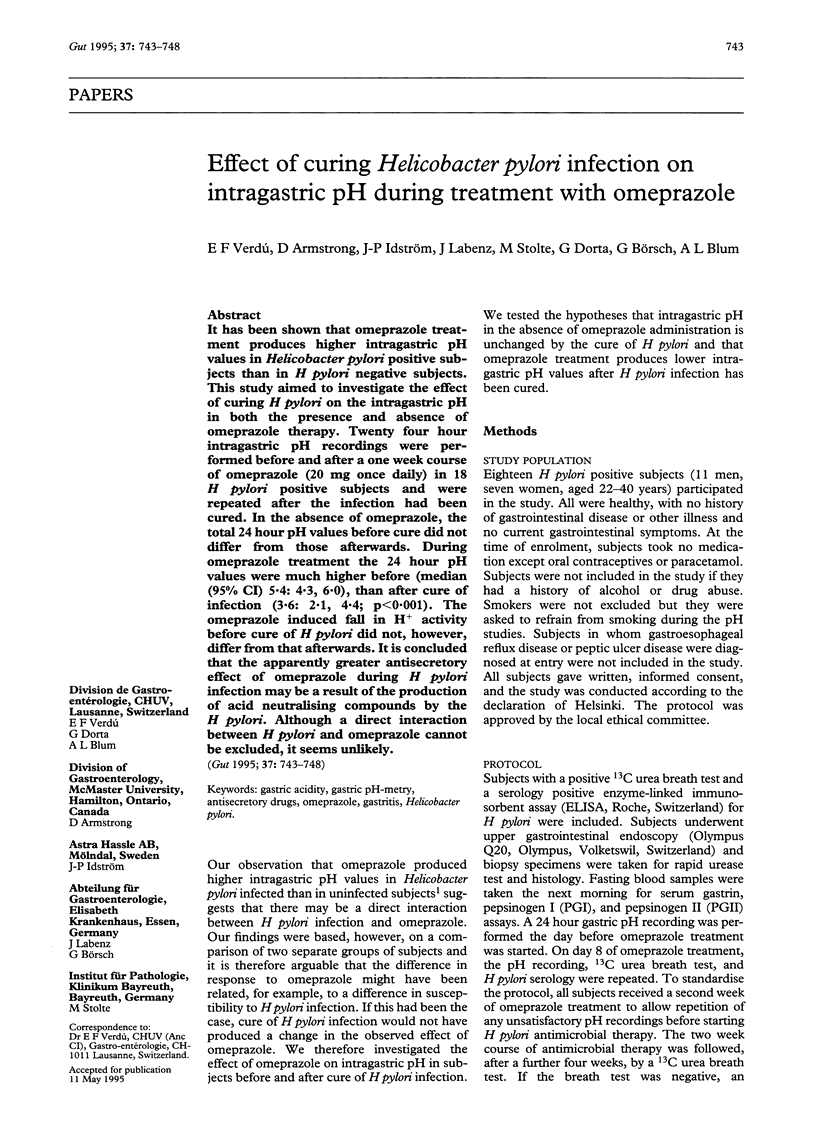
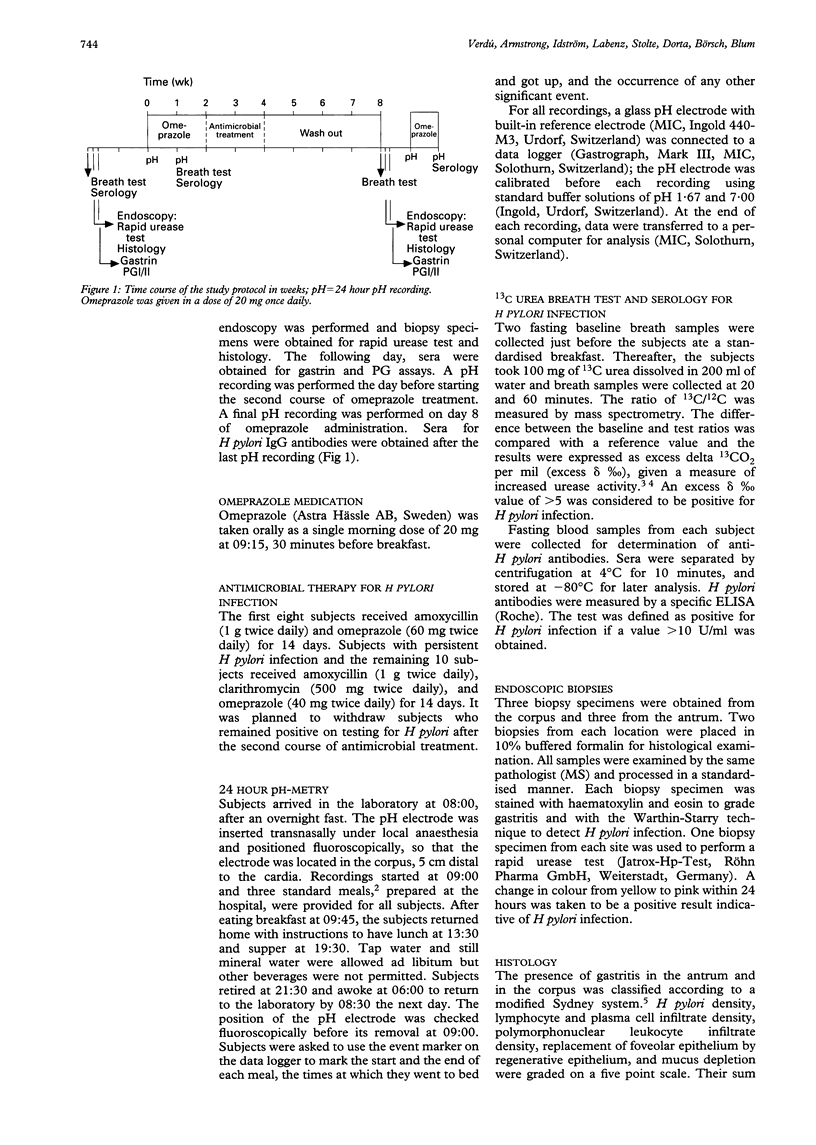
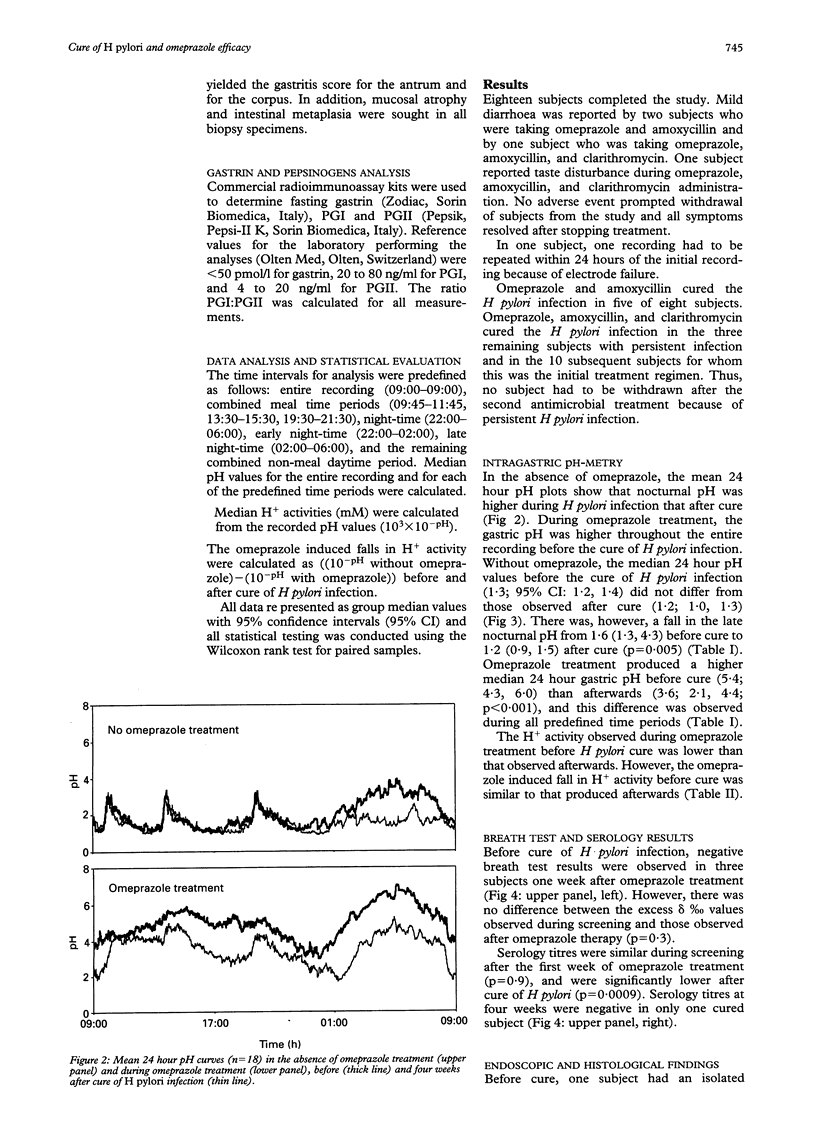
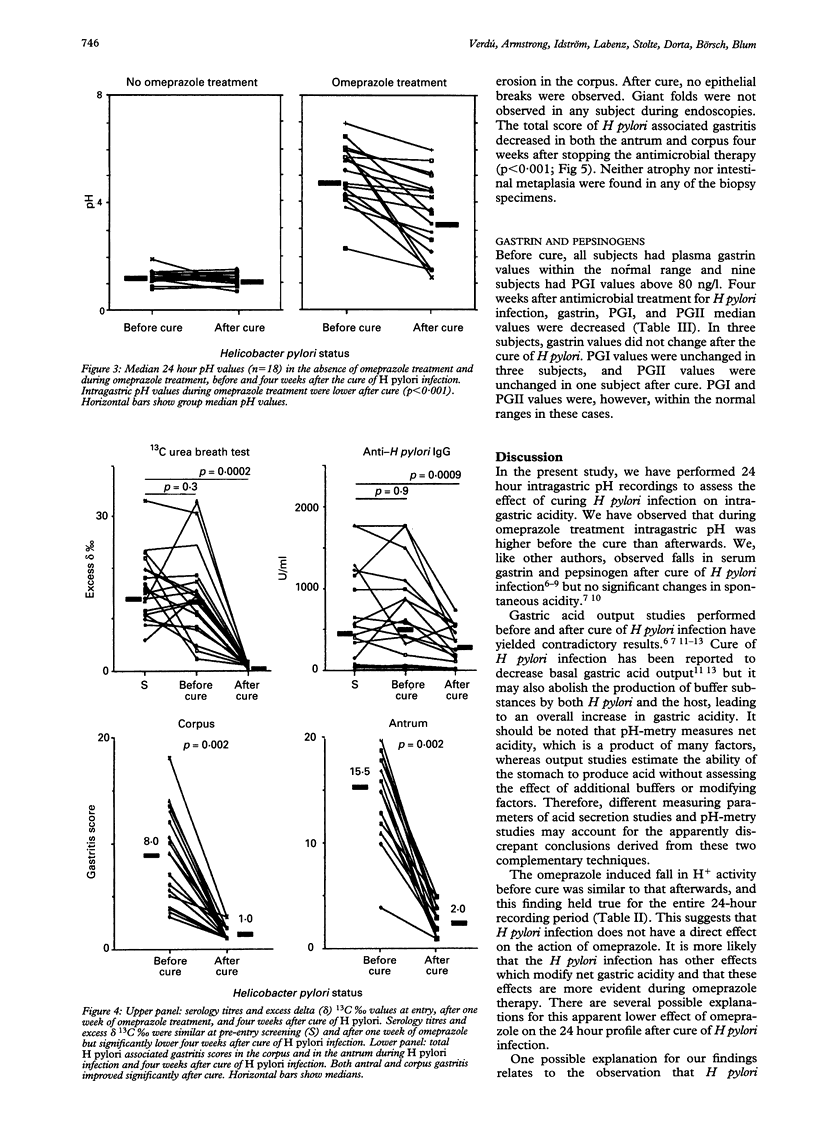
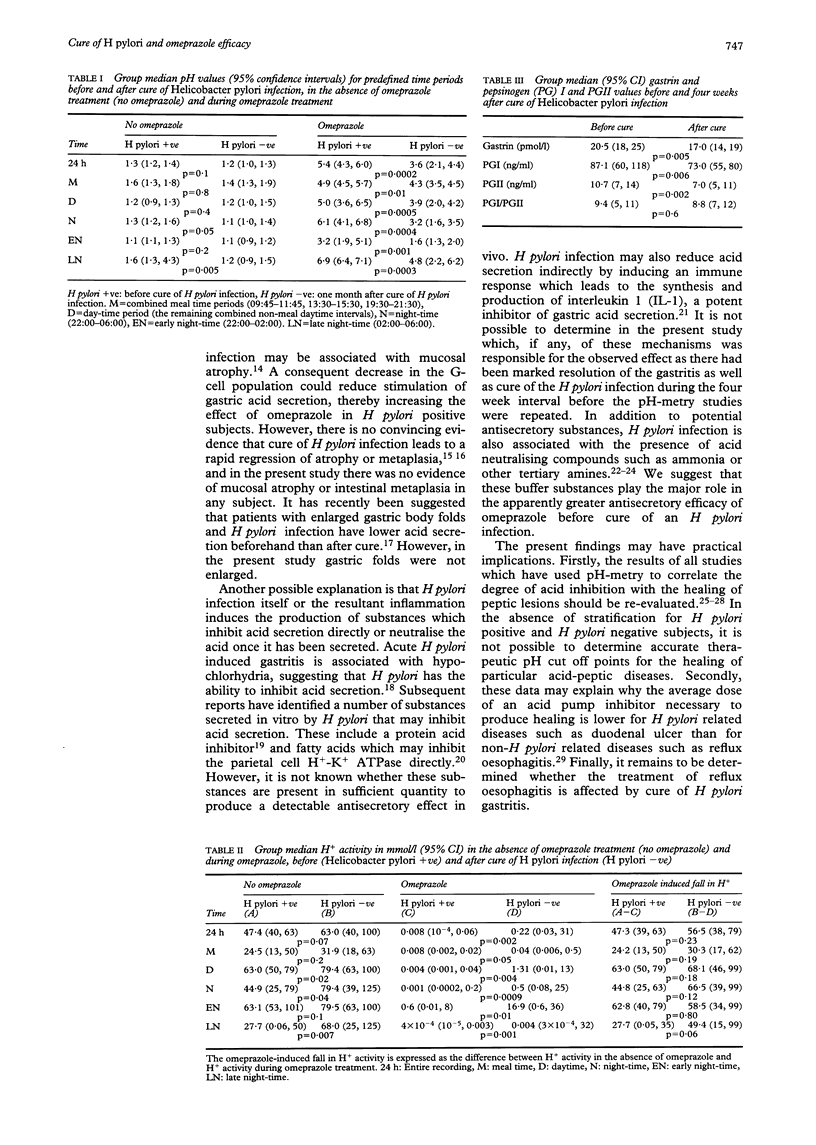
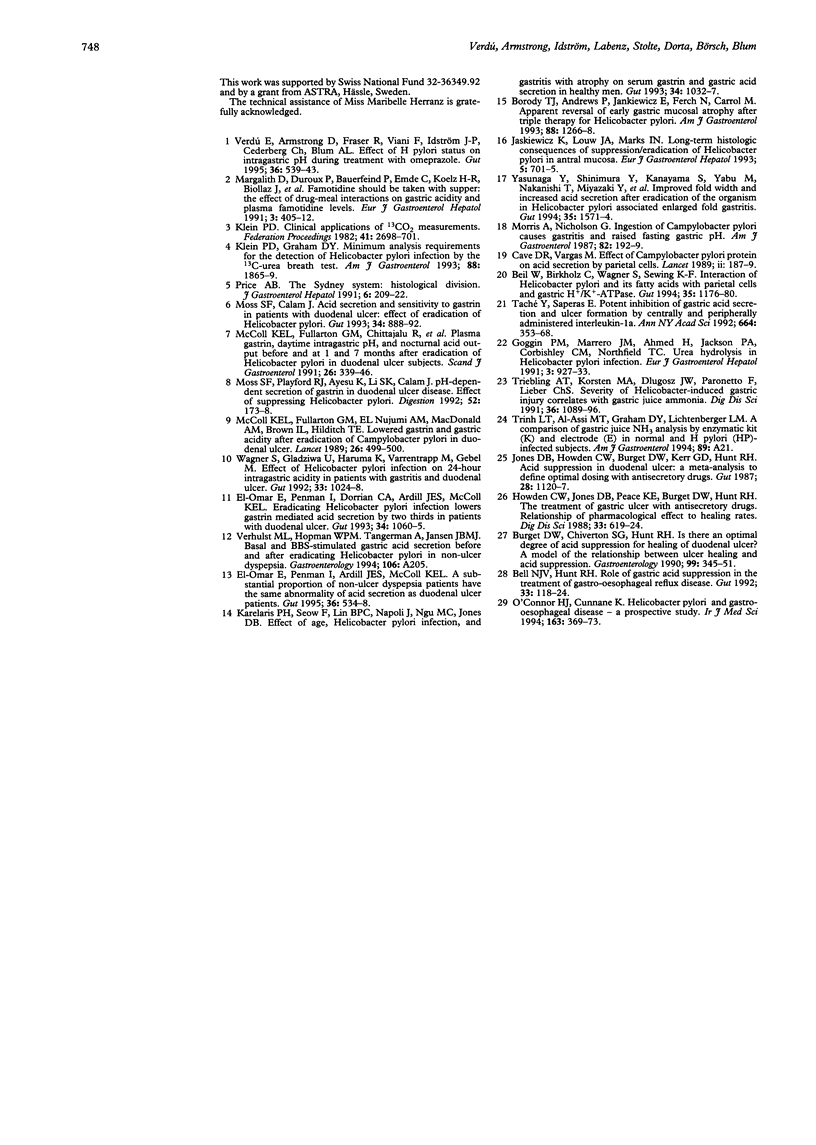
Selected References
These references are in PubMed. This may not be the complete list of references from this article.
- Beil W., Birkholz C., Wagner S., Sewing K. F. Interaction of Helicobacter pylori and its fatty acids with parietal cells and gastric H+/K(+)-ATPase. Gut. 1994 Sep;35(9):1176–1180. doi: 10.1136/gut.35.9.1176. [DOI] [PMC free article] [PubMed] [Google Scholar]
- Bell N. J., Hunt R. H. Role of gastric acid suppression in the treatment of gastro-oesophageal reflux disease. Gut. 1992 Jan;33(1):118–124. doi: 10.1136/gut.33.1.118. [DOI] [PMC free article] [PubMed] [Google Scholar]
- Borody T. J., Andrews P., Jankiewicz E., Ferch N., Carroll M. Apparent reversal of early gastric mucosal atrophy after triple therapy for Helicobacter pylori. Am J Gastroenterol. 1993 Aug;88(8):1266–1268. [PubMed] [Google Scholar]
- Burget D. W., Chiverton S. G., Hunt R. H. Is there an optimal degree of acid suppression for healing of duodenal ulcers? A model of the relationship between ulcer healing and acid suppression. Gastroenterology. 1990 Aug;99(2):345–351. doi: 10.1016/0016-5085(90)91015-x. [DOI] [PubMed] [Google Scholar]
- Cave D. R., Vargas M. Effect of a Campylobacter pylori protein on acid secretion by parietal cells. Lancet. 1989 Jul 22;2(8656):187–189. doi: 10.1016/s0140-6736(89)90372-3. [DOI] [PubMed] [Google Scholar]
- Howden C. W., Jones D. B., Peace K. E., Burget D. W., Hunt R. H. The treatment of gastric ulcer with antisecretory drugs. Relationship of pharmacological effect to healing rates. Dig Dis Sci. 1988 May;33(5):619–624. doi: 10.1007/BF01798367. [DOI] [PubMed] [Google Scholar]
- Jones D. B., Howden C. W., Burget D. W., Kerr G. D., Hunt R. H. Acid suppression in duodenal ulcer: a meta-analysis to define optimal dosing with antisecretory drugs. Gut. 1987 Sep;28(9):1120–1127. doi: 10.1136/gut.28.9.1120. [DOI] [PMC free article] [PubMed] [Google Scholar]
- Katelaris P. H., Seow F., Lin B. P., Napoli J., Ngu M. C., Jones D. B. Effect of age, Helicobacter pylori infection, and gastritis with atrophy on serum gastrin and gastric acid secretion in healthy men. Gut. 1993 Aug;34(8):1032–1037. doi: 10.1136/gut.34.8.1032. [DOI] [PMC free article] [PubMed] [Google Scholar]
- Klein P. D. Clinical applications of 13CO2 measurements. Fed Proc. 1982 Aug;41(10):2698–2701. [PubMed] [Google Scholar]
- Klein P. D., Graham D. Y. Minimum analysis requirements for the detection of Helicobacter pylori infection by the 13C-urea breath test. Am J Gastroenterol. 1993 Nov;88(11):1865–1869. [PubMed] [Google Scholar]
- McColl K. E., Fullarton G. M., Chittajalu R., el Nujumi A. M., MacDonald A. M., Dahill S. W., Hilditch T. E. Plasma gastrin, daytime intragastric pH, and nocturnal acid output before and at 1 and 7 months after eradication of Helicobacter pylori in duodenal ulcer subjects. Scand J Gastroenterol. 1991 Mar;26(3):339–346. doi: 10.3109/00365529109025052. [DOI] [PubMed] [Google Scholar]
- McColl K. E., Fullarton G. M., el Nujumi A. M., Macdonald A. M., Brown I. L., Hilditch T. E. Lowered gastrin and gastric acidity after eradication of Campylobacter pylori in duodenal ulcer. Lancet. 1989 Aug 26;2(8661):499–500. doi: 10.1016/s0140-6736(89)92105-3. [DOI] [PubMed] [Google Scholar]
- Morris A., Nicholson G. Ingestion of Campylobacter pyloridis causes gastritis and raised fasting gastric pH. Am J Gastroenterol. 1987 Mar;82(3):192–199. [PubMed] [Google Scholar]
- Moss S. F., Calam J. Acid secretion and sensitivity to gastrin in patients with duodenal ulcer: effect of eradication of Helicobacter pylori. Gut. 1993 Jul;34(7):888–892. doi: 10.1136/gut.34.7.888. [DOI] [PMC free article] [PubMed] [Google Scholar]
- Moss S. F., Playford R. J., Ayesu K., Li S. K., Calam J. pH-dependent secretion of gastrin in duodenal ulcer disease: effect of suppressing Helicobacter pylori. Digestion. 1992;52(3-4):173–178. doi: 10.1159/000200950. [DOI] [PubMed] [Google Scholar]
- O'Connor H. J., Cunnane K. Helicobacter pylori and gastro-oesophageal reflux disease--a prospective study. Ir J Med Sci. 1994 Aug;163(8):369–373. doi: 10.1007/BF02942830. [DOI] [PubMed] [Google Scholar]
- Price A. B. The Sydney System: histological division. J Gastroenterol Hepatol. 1991 May-Jun;6(3):209–222. doi: 10.1111/j.1440-1746.1991.tb01468.x. [DOI] [PubMed] [Google Scholar]
- Taché Y., Saperas E. Potent inhibition of gastric acid secretion and ulcer formation by centrally and peripherally administered interleukin-1. Ann N Y Acad Sci. 1992;664:353–368. doi: 10.1111/j.1749-6632.1992.tb39774.x. [DOI] [PubMed] [Google Scholar]
- Triebling A. T., Korsten M. A., Dlugosz J. W., Paronetto F., Lieber C. S. Severity of Helicobacter-induced gastric injury correlates with gastric juice ammonia. Dig Dis Sci. 1991 Aug;36(8):1089–1096. doi: 10.1007/BF01297452. [DOI] [PubMed] [Google Scholar]
- Verdú E. F., Armstrong D., Fraser R., Viani F., Idström J. P., Cederberg C., Blum A. L. Effect of Helicobacter pylori status on intragastric pH during treatment with omeprazole. Gut. 1995 Apr;36(4):539–543. doi: 10.1136/gut.36.4.539. [DOI] [PMC free article] [PubMed] [Google Scholar]
- Wagner S., Gladziwa U., Haruma K., Varrentrapp M., Gebel M. Effect of Helicobacter pylori infection on 24 hour intragastric acidity in patients with gastritis and duodenal ulcer. Gut. 1992 Aug;33(8):1024–1028. doi: 10.1136/gut.33.8.1024. [DOI] [PMC free article] [PubMed] [Google Scholar]
- Yasunaga Y., Shinomura Y., Kanayama S., Yabu M., Nakanishi T., Miyazaki Y., Murayama Y., Bonilla-Palacios J. J., Matsuzawa Y. Improved fold width and increased acid secretion after eradication of the organism in Helicobacter pylori associated enlarged fold gastritis. Gut. 1994 Nov;35(11):1571–1574. doi: 10.1136/gut.35.11.1571. [DOI] [PMC free article] [PubMed] [Google Scholar]
- el-Omar E., Penman I., Ardill J. E., McColl K. E. A substantial proportion of non-ulcer dyspepsia patients have the same abnormality of acid secretion as duodenal ulcer patients. Gut. 1995 Apr;36(4):534–538. doi: 10.1136/gut.36.4.534. [DOI] [PMC free article] [PubMed] [Google Scholar]
- el-Omar E., Penman I., Dorrian C. A., Ardill J. E., McColl K. E. Eradicating Helicobacter pylori infection lowers gastrin mediated acid secretion by two thirds in patients with duodenal ulcer. Gut. 1993 Aug;34(8):1060–1065. doi: 10.1136/gut.34.8.1060. [DOI] [PMC free article] [PubMed] [Google Scholar]


